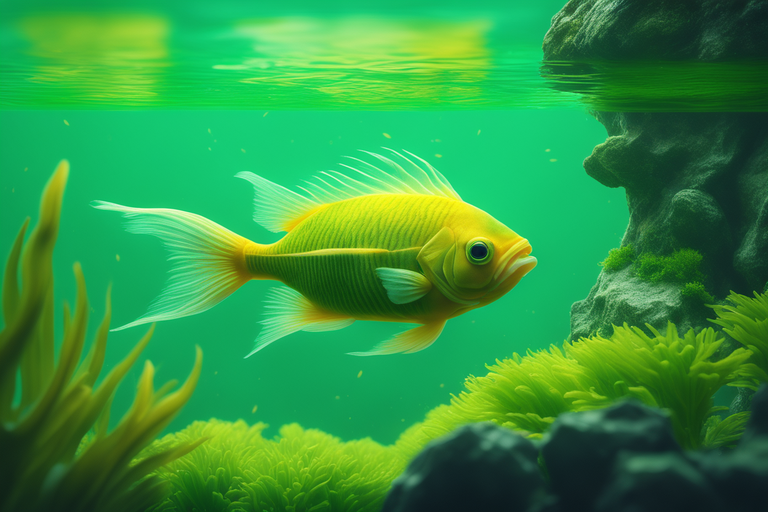Are you struggling to keep your planted aquarium algae-free? Don’t worry, it’s possible with the right strategies and techniques.
In this article, you’ll learn the factors that contribute to algae outbreaks and how to address them.
From tank maintenance and water changes, to lighting and circulation, to manual removal techniques, you can create a beautiful, algae-free aquarium and keep it that way.
Understanding Algae in Planted Aquariums
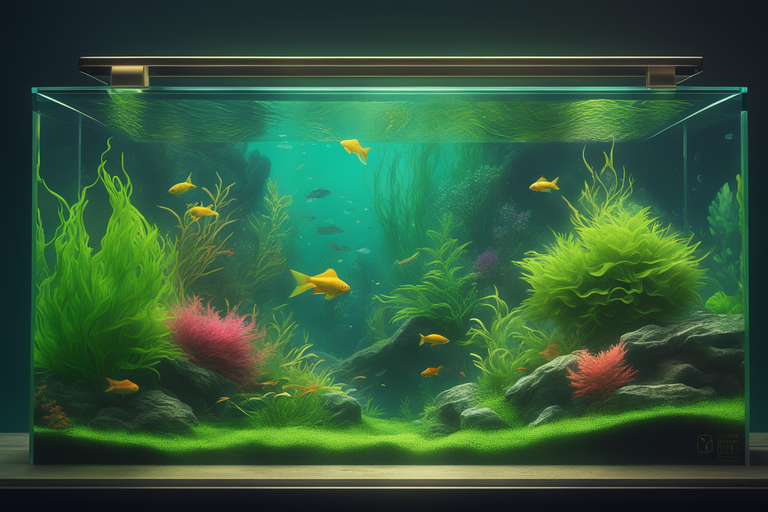
Understanding the different factors that contribute to algae growth in planted aquariums is key to preventing outbreaks. Algae are a common issue in aquascaping and are caused by an imbalance of light, CO2, and nutrients. Poor water circulation can also lead to an accumulation of organic waste, while insufficient beneficial bacteria in new setups can lead to excess ammonia. Oxygen depletion can occur due to a lack of surface agitation, while low populations of algae-eating animals like Amano shrimp and snails can also contribute to the problem. Low plant mass can also increase the risk of algae growth.
To control algae, you need to keep your tank healthy by providing proper water circulation, surface agitation, and lighting. You should also maintain a high plant mass from the beginning, including fast-growing plants and floating plants. It’s also important to ensure that all nutrients, including CO2, are balanced and measure CO2 with a drop checker. Regular maintenance should be done, including vacuuming and cleaning filter media, and weekly 50% water changes should be conducted in the first few weeks of a new setup. Finally, address common algae types in new setups, like brown algae (diatoms), with frequent water changes.
Preventing Algae Growth With Tank Maintenance

By maintaining a healthy tank and properly coordinating light, CO2, and nutrient levels, you can prevent algae growth in your planted aquarium. Cleaning the tank regularly, such as vacuuming the substrate and cleaning the filter media, can help remove organic waste and prevent algae from taking hold. Additionally, you should have a high plant mass and introduce fast-growing plants in the tank, as well as floating plants to provide shading and absorb excess nutrients.
Lighting is also an important factor, so you should use LED lighting with timers or dimmers to control the duration. Further, make sure to set up strong water flow and surface agitation to improve oxygenation and nutrient distribution. To balance the light, CO2, and nutrients, use a drop checker to monitor CO2 levels and a complete plant food for the tank.
Manual removal, adding a clean-up crew, and spot treating with hydrogen peroxide are some techniques you can use to control existing algae. A blackout technique, where you completely cover the tank and turn off the lights, can also help. However, the best way to prevent algae growth is to maintain a healthy tank with proper water changes and maintenance.
Planting Strategies to Reduce Algae
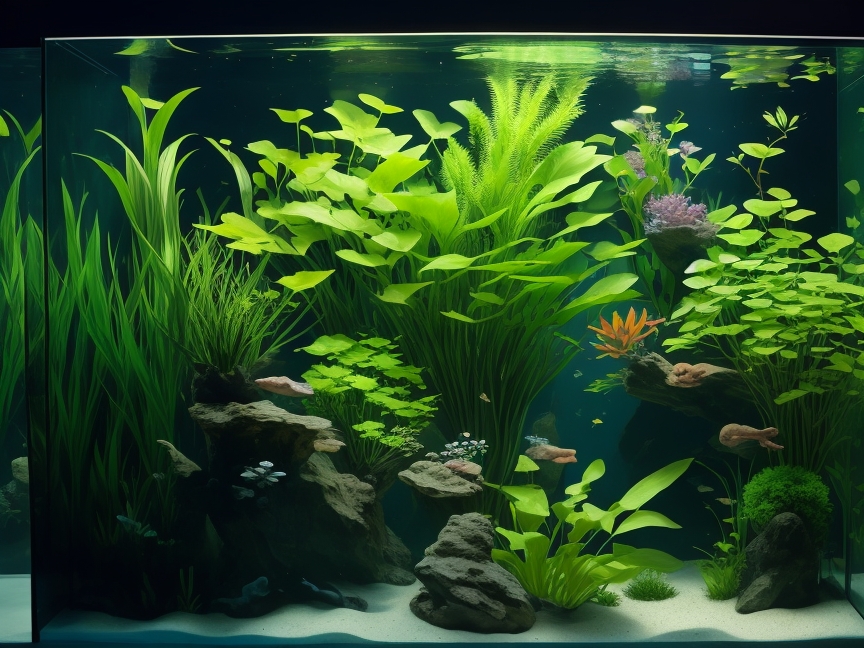
By using multiple plants, including fast-growing ones, and adding floating plants for shading, you can reduce algae growth and keep your aquarium healthy. Here are three ways to do so:
Planting Strategies:
- Plant many different types of plants, including fast-growing ones.
- Add floating plants to provide shade and use excess nutrients.
- Monitor CO2 levels and ensure proper lighting and circulation.
Algae Control Techniques:
- Manual removal.
- Add a clean-up crew (shrimp and snails).
- Blackout technique and spot treating with hydrogen peroxide.
Tank Maintenance:
- Perform weekly water changes of 50% in new setups.
- Ensure strong water flow and surface agitation.
- Balance light, CO2, and nutrient levels.
- Conduct regular maintenance.
- Keep a high plant mass from the beginning.
Considerations for Lighting and Circulation
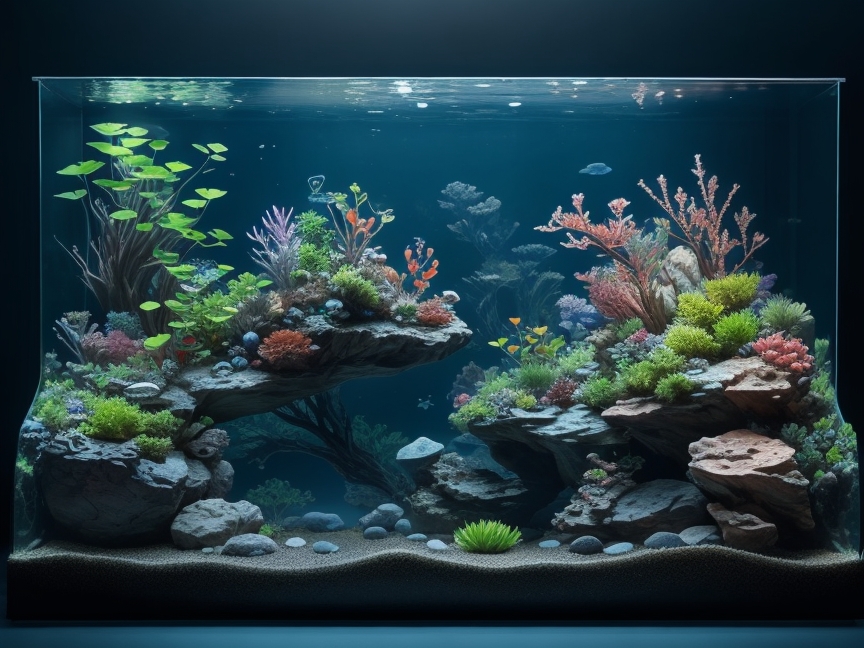
You should regularly check your aquarium’s lighting and circulation for optimal algae control. Lighting and water circulation are essential for keeping a healthy balance in an aquascaped tank, as they both play a role in keeping plants and algae in proper balance.
Proper lighting is necessary for photosynthesis, and this is one of the most important tasks for plant growth. Too much light can lead to rapid algae growth, so you should choose an appropriate LED lighting system with timers and dimmers for controlling the duration of lighting. Additionally, CO2 levels should be balanced and oxygen levels should be monitored to ensure that plants have enough of both for healthy growth.
Use an appropriate intensity of light for your specific tank setup. LED lights with adjustable settings are recommended as they allow you to control the brightness and duration.
- Avoid placing the aquarium near windows or other sources of direct sunlight, as this can lead to excessive lighting conditions.
- Implement a photoperiod (lighting schedule) that mimics natural day-night cycles. 8-10 hours of light per day is usually sufficient.
In terms of water circulation, it’s recommended to have at least 10 times the volume of the tank in flow per hour for proper nutrient distribution. This also helps to prevent oxygen depletion in the lower parts of the tank. Surface agitation is also necessary for oxygen levels, so you should consider an aquarium bubbler to help keep oxygen levels high.
- Install a quality aquarium filter with adequate flow rate for your tank size. The filter will help remove organic waste and excess nutrients from the water column.
- Consider adding a powerhead or air stone to create additional water movement if needed.
- Regularly clean and maintain your filtration system according to manufacturer guidelines.
Manual Algae Removal Techniques

There are several manual methods for algae removal in a fish tank. Here are some tips that are used techniques:
- Scrubbing: Use a scrub brush or sponge specifically designed for aquarium use to manually remove the algae from the sides of the tank glass or decorations. Gently scrub in circular motions, being careful not to scratch the glass.
- Algae scraper/pad: These tools have a long handle and an abrasive pad on one end. They can be used to scrape off stubborn algae from hard-to-reach areas of the tank, such as corners or crevices.
- Magnetic algae cleaner: This tool consists of two parts – one placed inside the aquarium and another outside with magnets that hold them together through the glass pane. By moving the exterior part along with water pressure, you can effectively clean off algae without having to reach into your tank.
- Toothbrush/old credit card: An old toothbrush or credit card can be useful for cleaning small cracks and hard-to-reach spots where larger tools may not work well.
- Water change/vacuuming: Regular water changes coupled with vacuuming gravel can help remove suspended organic material that promotes excessive algal growth.
- Manual removal by hand: If possible, carefully remove large visible clumps of filamentous algae (stringy green strands) by gently pulling them out using your fingers or tweezers.
Adding a Clean-Up Crew to Control Algae
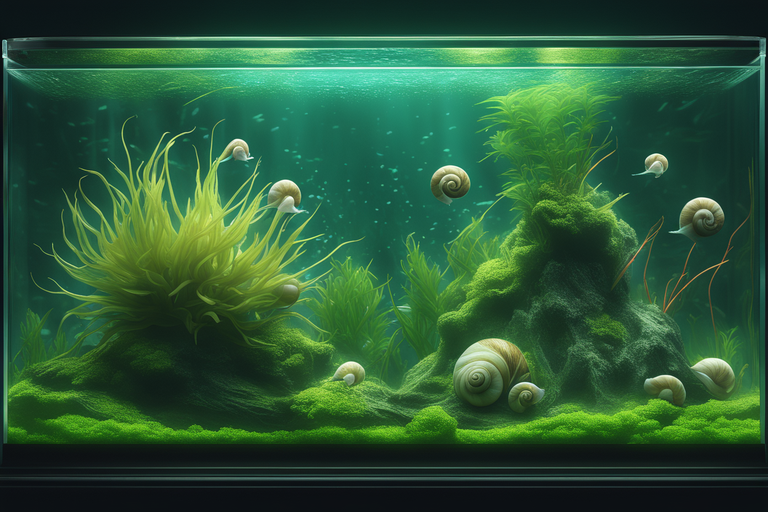
Have you considered adding a clean-up crew to help control algae in your aquarium? Adding a clean-up crew, such as snails and shrimp, can be an effective way to reduce algae growth in a planted tank. Here’s an overview of the benefits of a clean-up crew:
| Benefits | Advantages | Disadvantages |
|---|---|---|
| Cost | Affordable | No guarantee of success |
| Natural | Natural, no chemicals | Could bring unwanted parasites |
| Clean | Consume algae and debris | Can overpopulate |
A clean-up crew can consume algae and other debris, helping to keep the tank clean. They’re also very affordable and a natural solution, so you don’t have to worry about using chemicals. However, there’s no guarantee that adding a clean-up crew will solve your algae problem, and they can overpopulate if not managed properly. Additionally, they could bring unwanted parasites into the tank.
It’s important to research the types of clean-up crew that are suitable for your tank and the types of algae you have. Common examples are Amano shrimp, Malaysian trumpet snails, and nerite snails. It’s also wise to monitor your tank after adding the clean-up crew to ensure the algae levels remain low.
Using a Blackout Technique to Eliminate Algae
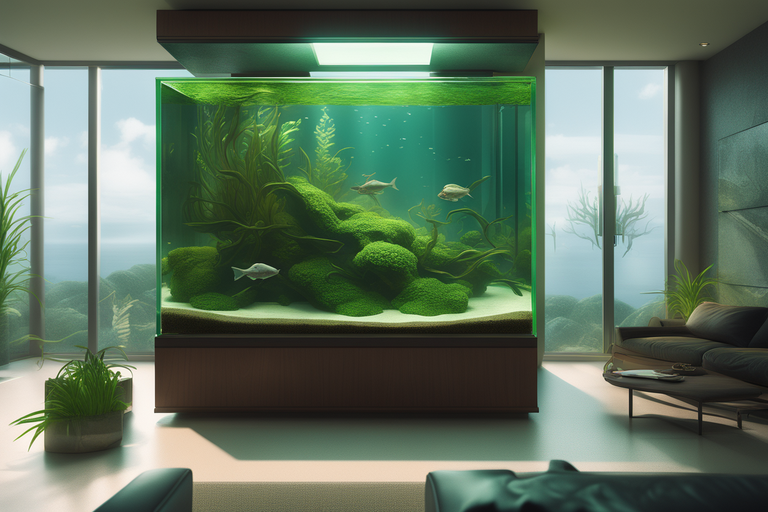
An effective way to combat algae in your aquarium is to try the blackout technique. This is a simple yet effective way to eliminate algae from your tank by reducing lighting to zero for a certain period of time. Here are some benefits of using this technique:
- Eliminates algae quickly:
- Denies algae the light it needs to photosynthesize
- Starves algae of the nutrients it needs
- Reduces stress on your tank:
- No need for adding chemicals or manual removal
- No risk of killing other beneficial organisms
- Improves overall tank health:
- Reduces algae population and competition for resources
- Increases the efficiency of your filter and other systems
This technique is easy to implement and works best when combined with other measures such as manual removal, adding a clean-up crew, and improving water circulation. A blackout usually lasts from three to seven days and can be repeated if necessary.
Remember to keep your tank covered during the blackout and turn off all light sources. After the blackout, take the necessary precautions to ensure that algae doesn’t return, such as regularly testing water parameters, maintaining a high plant mass, and using appropriate lighting.
Spot Treating With Hydrogen Peroxide
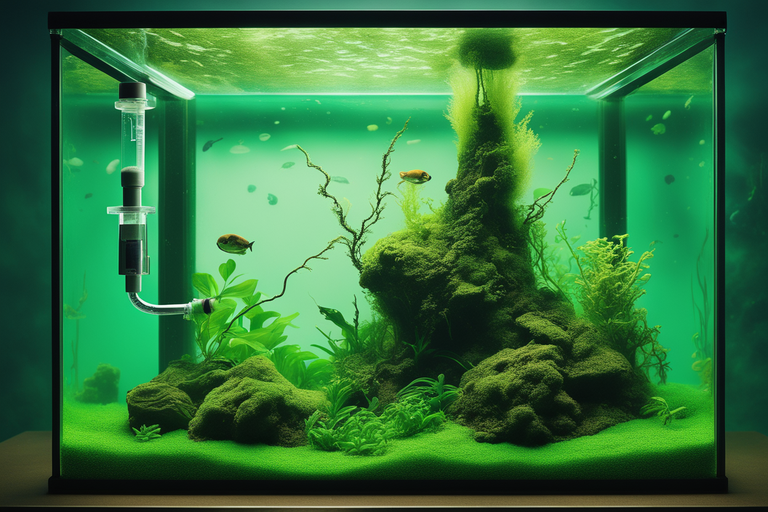
Interestingly, spot treating with hydrogen peroxide is another way to control algae in a planted aquarium. Hydrogen peroxide is an effective algaecide that can be used as a spot treatment for certain types of algae. When using hydrogen peroxide, it is important to use the correct dosage and to monitor the tank closely to ensure that the algae is not spreading.
| Pros | Cons |
|---|---|
| – Fast Acting | – Excessively High Dosage Can be Harmful |
| – Can be Used As a Spot Treatment | – Can Cause Stress to Fish and Plants |
| – Safe to Use With Plants | – Can be Difficult to Monitor |
In order to use hydrogen peroxide effectively, it is important to use the correct dosage and to monitor the tank closely. The recommended dosage is 1ml per 10 liters of water, and it should be used only once a week. The use of hydrogen peroxide can be beneficial in controlling certain types of algae, but it should be used with caution to avoid stressing out fish and plants.
Balancing Nutrients to Prevent Algae
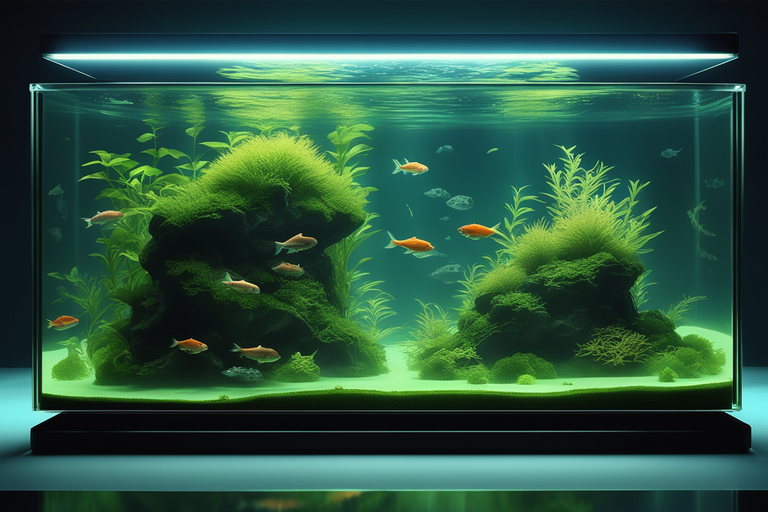
You can also prevent algae by balancing the nutrients in your aquarium. Nutrients are an essential component of a healthy planted tank, and an imbalance can result in algae blooms. Here are a few tips to help you get the nutrient balance right:
Water Chemistry:
- Monitor and adjust your water parameters regularly, such as pH, alkalinity, hardness, and nitrate levels.
- Make sure to use a high quality water conditioner to remove any toxins and pollutants from tap water.
Lighting:
- Use the right type of LED lighting for your tank and adjust the duration and intensity of the lights.
- Control the light duration with timers or dimmers to reduce the chances of algae growth.
Fertilization:
- Regularly fertilize your tank with a complete plant food to provide enough nutrients for the plants.
- Consider injecting CO2 into the aquarium to create a nutrient-rich environment for the plants.
Best Practices for Maintaining an Algae-Free Aquarium
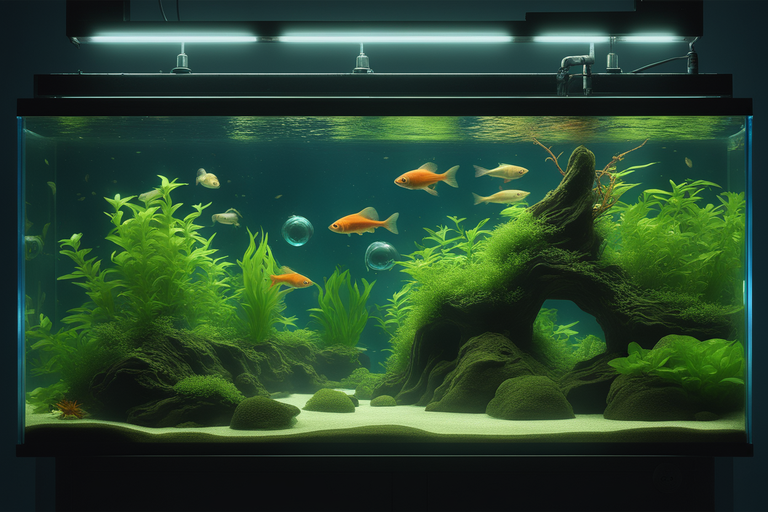
By properly maintaining your aquarium, you can keep algae growth at bay. Water changes, proper lighting, and circulation are essential elements for an algae-free tank. Planting strategies such as using many plants, including fast-growing ones, and floating plants to provide shade can help reduce algae growth.
To ensure proper lighting, you should use LED lighting and adjust the duration with timers or dimmers. CO2 dispersion and water circulation must also be managed to prevent algae outbreaks. Additionally, manual removal, adding a clean-up crew (shrimp and snails), blackout technique, and spot treating with hydrogen peroxide can be used to control algae growth.

